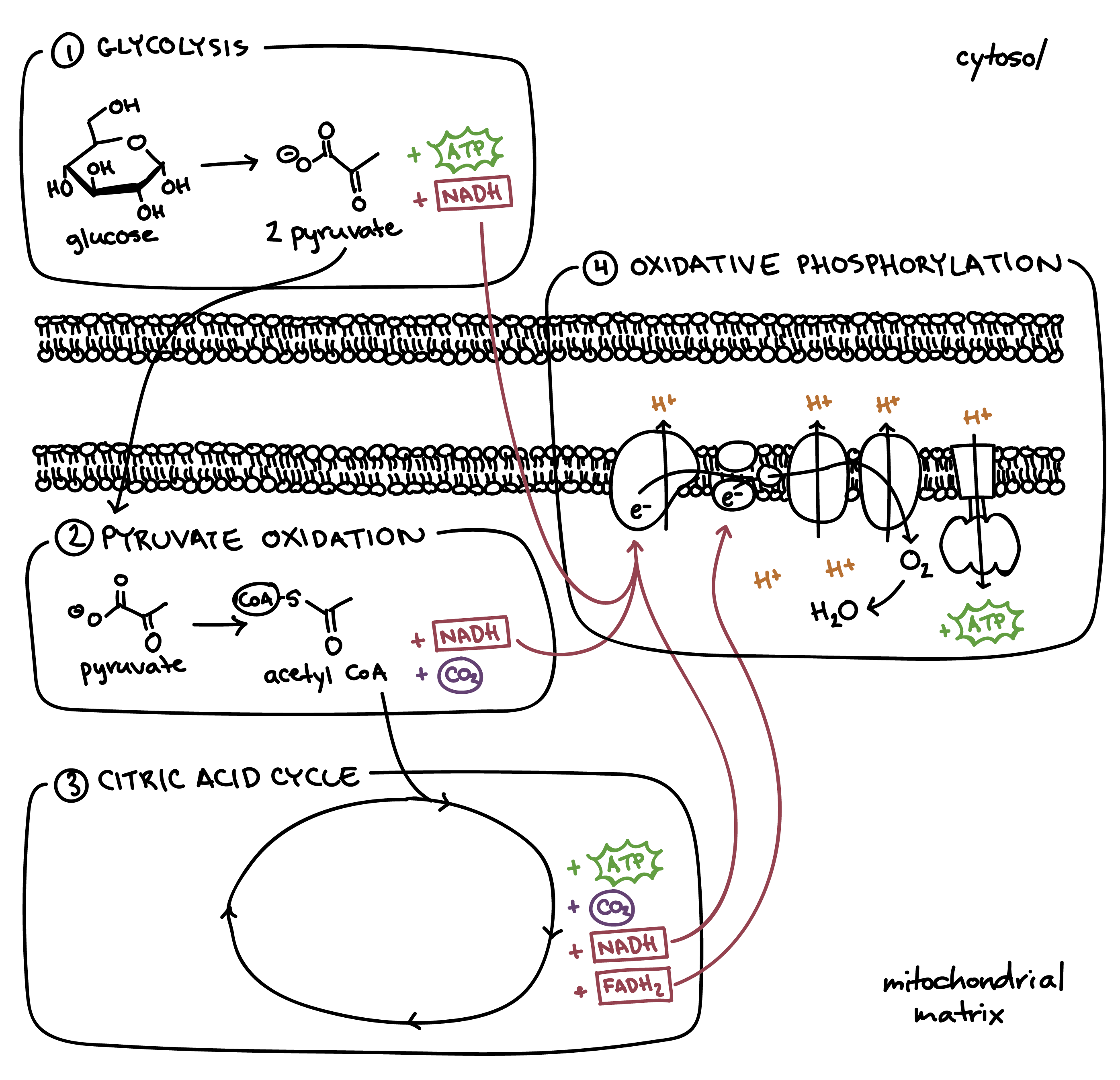Overview of cellular respiration
Steps of cellular respiration
Introduction
Cellular respiration is one of the most elegant, majestic, and fascinating metabolic pathways on earth. At the same time, it’s also one of the most complicated. When I learned about it for the first time, I felt like I had tripped and fallen into a can of organic-chemistry-flavored alphabet soup!
Luckily, cellular respiration is not so scary once you get to know it. Let's start by looking at cellular respiration at a high level, walking through the four major stages and tracing how they connect up to one another.
Steps of cellular respiration

During cellular respiration, a glucose molecule is gradually broken down into carbon dioxide and water. Along the way, some ATP is produced directly in the reactions that transform glucose. Much more ATP, however, is produced later in a process called oxidative phosphorylation. Oxidative phosphorylation is powered by the movement of electrons through the electron transport chain, a series of proteins embedded in the inner membrane of the mitochondrion.
These electrons come originally from glucose and are shuttled to the electron transport chain by electron carriers \[\text{NAD}^+\] and \[\text{FAD}\], which become \[\text{NADH}\] and \[\text{FADH}_2\] when they gain electrons. To be clear, this is what's happening in the diagram above when it says \[+\] \[ \text{NADH}\] or \[+\] \[ \text{FADH}_2\]. The molecule isn't appearing from scratch, it's just being converted to its electron-carrying form:
\[\text{NAD}^+\] \[+\] \[2 e^-\] \[+\] \[2 \text H^+\] \[\rightarrow\] \[\text{NADH}\] \[+\] \[\text H^+\]
\[\text{FAD}\] \[+\] \[2e^-\] \[+\] \[2 \text H^+\] \[\rightarrow\] \[\text{FADH}_2\]
To see how a glucose molecule is converted into carbon dioxide and how its energy is harvested as ATP and \[\text{NADH}\]\[/\]\[\text{FADH}_2\] in one of your body's cells, let’s walk step by step through the four stages of cellular respiration.
Glycolysis. In glycolysis, glucose—a six-carbon sugar—undergoes a series of chemical transformations. In the end, it gets converted into two molecules of pyruvate, a three-carbon organic molecule. In these reactions, ATP is made, and \[\text{NAD}^+\] is converted to \[\text{NADH}\].
Pyruvate oxidation. Each pyruvate from glycolysis goes into the mitochondrial matrix—the innermost compartment of mitochondria. There, it’s converted into a two-carbon molecule bound to Coenzyme A, known as acetyl CoA. Carbon dioxide is released and \[\text{NADH}\] is generated.
Citric acid cycle. The acetyl CoA made in the last step combines with a four-carbon molecule and goes through a cycle of reactions, ultimately regenerating the four-carbon starting molecule. ATP, \[\text{NADH}\], and \[\text{FADH}_2\] are produced, and carbon dioxide is released.
Oxidative phosphorylation. The \[\text{NADH}\] and \[\text{FADH}_2\] made in other steps deposit their electrons in the electron transport chain, turning back into their "empty" forms (\[\text{NAD}^+\] and \[\text{FAD}\]). As electrons move down the chain, energy is released and used to pump protons out of the matrix, forming a gradient. Protons flow back into the matrix through an enzyme called ATP synthase, making ATP. At the end of the electron transport chain, oxygen accepts electrons and takes up protons to form water.
Glycolysis can take place without oxygen in a process called fermentation. The other three stages of cellular respiration—pyruvate oxidation, the citric acid cycle, and oxidative phosphorylation—require oxygen in order to occur. Only oxidative phosphorylation uses oxygen directly, but the other two stages can't run without oxidative phosphorylation.
Each stage of cellular respiration is covered in more detail in other articles and videos on the site. Try watching the overview video, or jump straight to an article on a particular stage by using the links above.
